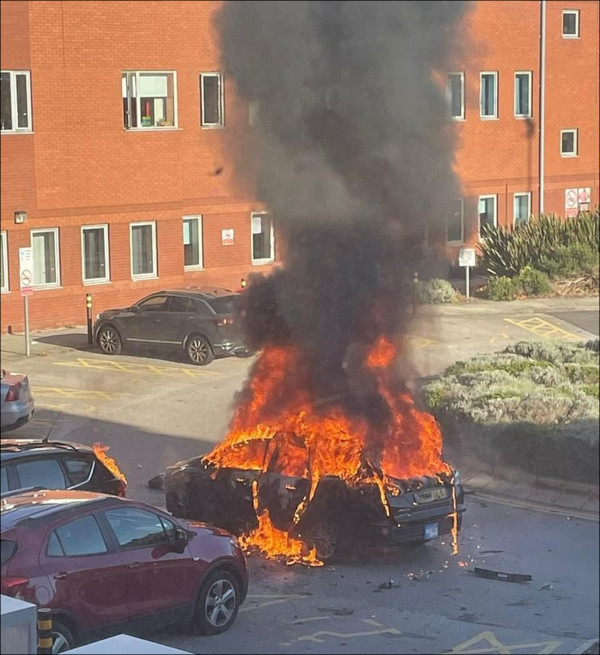The Liverpool Women’s Hospital incident; Part Two: take our “how determined a jihadist are you?” quiz
When Emad Al Swealmeen “set off a bomb” outside a hospital on “Remembrance Sunday” (just before the oh-so symbolic 11-o-clock signal to worship the transfigured sacrifice in the temple ritual that takes place every year), it was a UK Government propagandist’s dream come true, because it suited all the messaging that had been pumped out during the course of nearly two years, and a fake pandemic.
To have a “bomb” go off at a hospital on Remembrance Sunday would mean the creation of actual equivalence between the victimhood at the hands of an unreasoning and merciless force (terror, also symbolising, in fact, a disease that can’t be controlled) suffered by an especially beloved institution (a baby delivery facility) within an adored, nay venerated national institution, and the death in combat of members of the country’s armed services.
As we know, it was very early on in the fake pandemic that UK Government elevated the sainted NHS into a fighting force against what was portrayed as a peril that threatened the national welfare. So, to have the NHS take a hit as though actually in a war is merely to reinforce the elevation. Or, to have a scenario where there is a representation of the institutions and the way of life being bombed with an overt link existing to tie it to war time spirit, then it means having a development where the metaphor of health service as combatant goes from being symbolic to material.
From a perspective of whose propaganda is best suited by a “bomb” at Liverpool Women’s Hospital, that of the UK Government, or that of a nearly anonymous, pseudo-jihadist (because the authorities, in part by being seen to make further arrests and give the impression of a “cell” [that doesn’t actually seem to exist] rushed to signal the incident was borne out of Islamist terror), there is no doubt about the answer to the question, cui bono?
As it happens, there has been an effort to pre-emptively obstruct a rationalisation to the above conclusion by making, in the official narrative, the hospital a Plan-B target after a primary one could not be reached. We are told that Al Swealmeen tried to get to Liverpool Cathedral where a Remembrance service was taking place, but that roads were closed to prevent him getting there as he required, and so he changed his mind about where he would like to detonate his “bomb”.
But, this is feeble. It relies on everyone believing that this individual cannot make simple choices about how to be in a particular place at a certain time: that he can’t decide to depart earlier to deal with unforeseen contingencies.
Besides which, why on earth did Michael Adebolajo – or his script writer – go to all the trouble of crafting that “so what if we want to live by Sharia in Muslim lands?” speech, with its focus on the dispensing of an eye for an eye in retaliation for Western military adventurism, regretting there had to be any involvement of women, if it has all been so easily forgotten? And this is important, because of course the hospital was a maternity one. Again, we must ask, with Al Swealmeen being characterised as a Muslim extremist, whose real desire is better expressed, and whose purpose is better served to target a women’s hospital rather than the pagan ritual worshiping dead soldiers and sailors?
As the reader will probably now know, an explosive device (the real nature of which is due for investigation in a further article) went off in the taxi that Al Swealmeen had been riding in when it arrived at the hospital, and before either the so-called terrorist or indeed the driver could leave the vehicle. After the explosion had occurred, the latter of the two exited (and this astonishing aspect of the story, again, will be dealt with in a further article), but the “bomber” remained in the car. Indeed, Al Swealmeen did not react at all as a fire caught hold and eventually consumed the whole vehicle. If the reader will look at the image below, along with the extract from The Telegraph’s live updates [via MSN], the information combines to reveal that Fire and Rescue appears to define a nearly completely burnt out vehicle as suffering from a “fully developed” fire:
Phil Garrigan, chief fire officer of Merseyside Fire and Rescue Service, said the car fire at Liverpool Women’s Hospital was “fully developed” when two appliances arrived shortly after 11am.
He told reporters at the scene: “The operational crews extinguished the fire rapidly but as has been reiterated by the police chief constable, there was one fatality.
The information will also probably combine to inform the reader, as it does the author, that Al Swealmeen, sitting in the midst of this conflagration, must have been reduced to something where identity could not have been readily gleaned from his remains – and this is something that is going to feature as an aspect in a thought exercise that the reader is now asked to conduct.
Image, reader, that you are Al Swealmeen, and you are in the taxi arriving at the Women’s Hospital, but the driver locks the doors before the car stops so that you won’t be able to exit the vehicle (this is the official narrative as the author understands it at the time of writing).
Do you,
A) threaten the driver, and even attack him if you can see a way of doing it, until he lets you out – you are an evil jihadist after all, and as per the pattern that is now well established, you have probably brought the whole knife drawer with you?
B) wait for the arrival of the coppers because you understand that the game is up, but decide that you still might be able to take a few of them with you?
C) blow yourself up, because:
i) it suddenly doesn’t matter to you that nothing came of your well laid plans, and your bomb-making (the official narrative makes Al Swealmeen the manufacturer of the device), and you won’t even try to think of trying to live to fight another day?
ii) being burnt to a crisp in the fire that is bound to ensue after the explosion will make you anonymous so that your name won’t be linked with such a colossal failure, and perhaps more importantly you won’t incriminate anyone who could be linked to you – forgetting of course that you had the taxi pick you up from your home (as the official narrative suggests)?
or iii) you are unhappy with your life as a failed asylum seeker, although this doesn’t hinder you from living in Britain, nor indeed renting your flat on Rutland Avenue?
or D) attempt to talk your way out of the situation by reassuring the driver that you aren’t going to do a runner (he doesn’t know for sure you are packing explosive), so the locked door is redundant and a little bit insulting, and then, giving the driver the fare, act as if you expect to get out of the cab as per normal to go about your business?
Which would you do, reader, if you were this determined “jihadist” whose only obstacle to completing his mission was the little hiccup of a locked taxi door?
Perhaps, after the scenario can be deconstructed in the way it has above, the military intelligence narrative concerning the whys and hows of who made the “bomb” and who set it off should be rejected. Instead, things might make better sense if the explosion was according to a timer that Al Swealmeen was either ignorant of, or could do nothing about. This would have the ramification whereby the “bomb” would most likely be something supplied to him rather than of his own making – and this would open a whole can of worms.
Another reasonable explanation would be that the explosion happened by accident: the “bomb” detonated before it was meant to. However, when one starts down that path of questioning (as precedent informs) there is a risk of arriving at a conclusion that the “bomb” maker was inept in those terms, and in fact was more likely than not to be too inept to concoct anything that could ever detonate. At that point, it becomes simpler to understand that the “bomb” was supplied. Again – can of worms.
Now, there’s no doubt that the security services are going to release general data about the improvised explosive device used (or the same will be divulged at an inquiry), and so there will be a time later to perform analysis of that – bearing in mind that this would be looking at detail populating the universe where terror attacks are never performed by the State. Nevertheless, there will no doubt be clues as to the truth, which we can begin to guess at by studying the prime piece of evidence that was very quickly released into the public domain, and consists of a CCTV film that records the explosion as it happened, and in fact its peculiar behaviour and affect. It is behaviour that suggests that the “bombing” was not at all what it has been portrayed to be, and the task of noting the reasons for having this understanding is for the very next article in this series. After that, there will be an article about the rush to a terror narrative despite “car bombs” not being unheard of in Liverpool, and how this particular set of circumstances more than usual indicates the presence of foreknowledge.




















Always interesting to read your take on events.
Other strange features of this case include the alleged bomber’s name (reads like “He’s mad as well, man”) and his status as an “apostate” and former inmate of a psychiatric facility.
Spooky Lt Col Hitchcott was the Secretary of an outfit called “Evangelism Explosion” from 2009 – 2012
https://find-and-update.company-information.service.gov.uk/company/01215045/officers
Regarding the explosion, it looked much more like an “incendiary device” being triggered than an actual IED
The explosion was tiny and the fire developed unnaturally quickly – in the photo above there appears to be burning material flowing out of and pooling under the car.